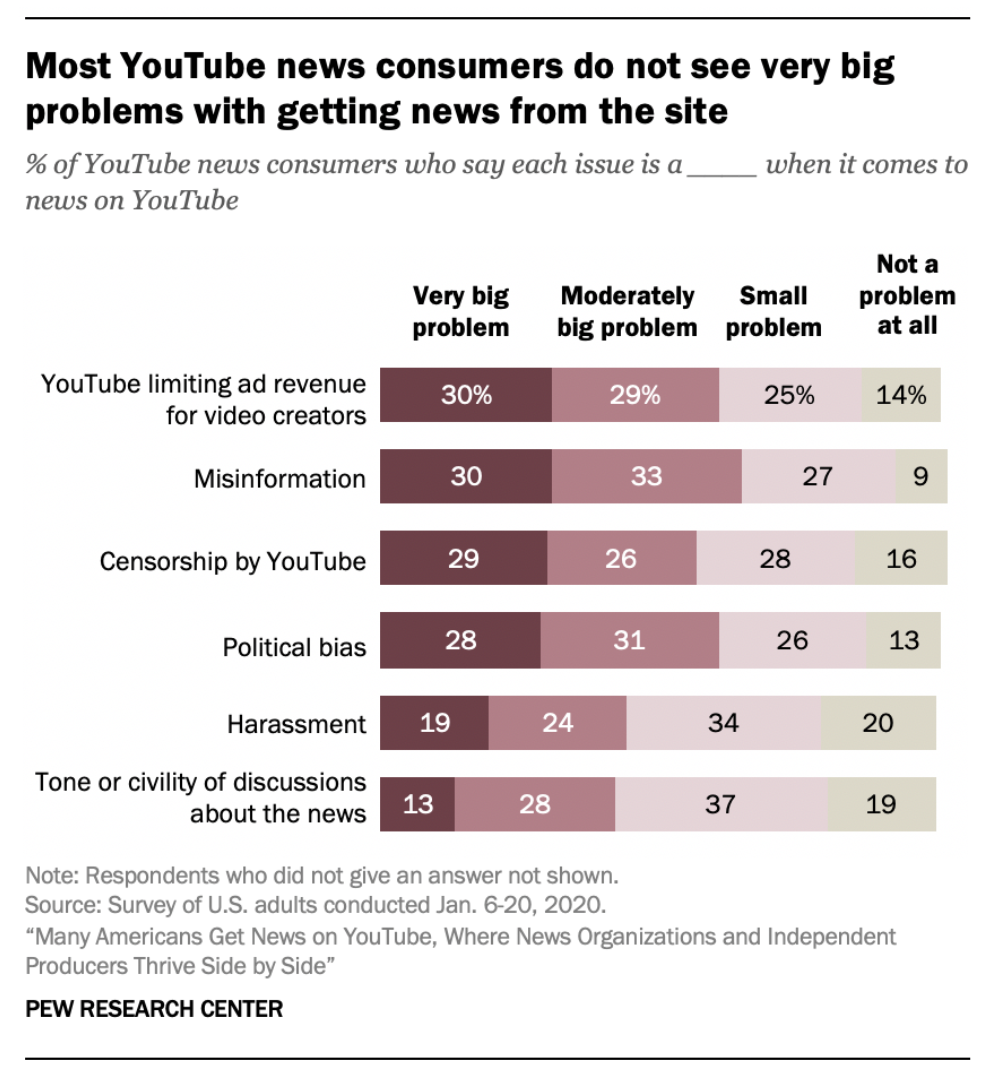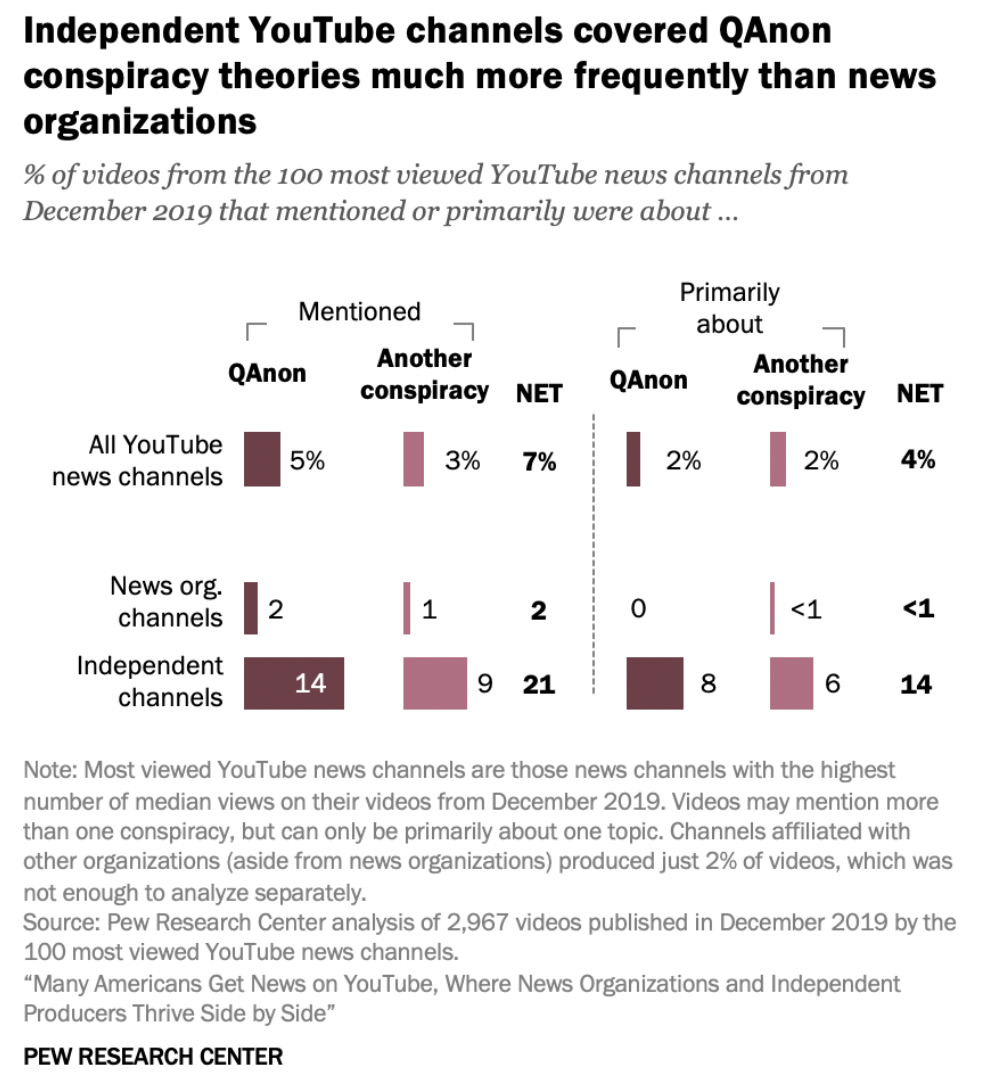Twenty-six percent of American adults get news from YouTube, according to a new study by the Pew Research Center. And 13% of those say YouTube is the most important way they get news.
The Center studied the platform, which has more than two billion monthly users, by conducting a survey of over 12,000 U.S. adult YouTube news consumers in January 2020 and asking them about their experiences. Then Pew analyzed the most popular YouTube news channels and the contents of the videos some of those channels published in December 2019.
Pew found that of the 377 most popular YouTube news channels, 49% belong to news organizations while 42% belong to independent channels or creators. Among news consumers, 23% said they often watch videos by news outlets and independent channels. Established news outlets “no longer have full control over the news Americans watch,” Pew notes.
Those YouTube news consumers feel pretty much fine about getting information from the site, though nearly a third think misinformation there is a “very big problem” and another 33% think it is a “moderately big problem.” Democrats were more likely than Republicans to say misinformation and harassment are “very big problems” on the platform, compared to Republicans who were more likely to say the same about demonetization, censorship, and political bias.

The content analysis also found that the styles and content of news videos vary widely, from video length to upload frequency. “During the period analyzed (December 2019), news organizations posted a much higher volume of videos than independent sources (33 vs. 12 for the typical channel of each type), while independent channels’ videos were typically much longer (more than 12 minutes, compared with about five minutes for videos from channels affiliated with news organizations),” the researchers write.
The report also notes that 44% of these news channels are centered around YouTubers instead of what we think of as more traditional journalists:
The content analysis also finds that most of these independent channels are centered around an individual personality — often somebody who built their following through their YouTube channel — rather than a structured organization.
While 22% of popular YouTube news channels affiliated with a news organization use this personality-driven structure, seven-in-ten of the most popular independent news channels are oriented around a personality. And the people at the center of most of these independent channels are often “YouTubers” (i.e., people who gained a following through their YouTube presence; 57% of all independent news channels) rather than people who were public figures before gaining attention on YouTube (13%).
These different offerings and approaches to the news could have a variety of implications for the experiences of people who get news on YouTube. On the one hand, most YouTube news consumers seem to have a positive experience. Clear majorities in this group say in the survey that the news videos they watch on YouTube help them better understand current events (66%) and expect them to be largely accurate (73%). And a similar share (68%) say the videos keep their attention and that they typically watch closely, rather than playing them in the background.
Independent channels are also much more likely to cover QAnon conspiracy theories than established news organizations. Of the 100 most viewed YouTube news channels, just 2% of videos by traditional news organizations even mentioned QAnon or another conspiracy. Among independent news channels, that shot up to 21%.

Read the full report here.
I'm disturbed that anyone – let alone 13% of Americans – say "the most important way" they get their news is YouTube.
No wonder belief in conspiracy theories is so prevalent. https://t.co/OEeKADMslT
— Christina Farr (@chrissyfarr) September 28, 2020
YouTube news consumers generally approve of their experience. Majorities say news videos there help them better understand current events, and are largely accurate. And given a list of six potential problem areas, no more than three-in-ten see each as a very big problem. pic.twitter.com/x7gcXEPMxL
— Mike Barthel (@michaelbarthel) September 28, 2020
Pew analysis of thousands of videos posted Dec '19 show that when looking only at videos from independent channels, 14% were primarily about Qanon, Epstein or anti-vaccine conspiracy theories. A higher share (21%) mentioned at least 1 of those conspiracies https://t.co/PeLj8UBRii
— Laura Barrón-López (@lbarronlopez) September 28, 2020
YouTube is a huge source of information for Americans—including political information. Yet it's relatively understudied, especially in political science. Great work here by @pewresearch https://t.co/dZQPb0EJkl
— Jonathan Ladd (@jonmladd) September 29, 2020
Leave a comment